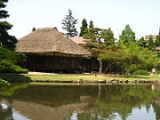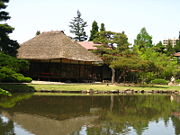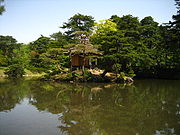
Aizu Matsudaira's Royal Garden
Encyclopedia

Herbalism
Herbalism is a traditional medicinal or folk medicine practice based on the use of plants and plant extracts. Herbalism is also known as botanical medicine, medical herbalism, herbal medicine, herbology, herblore, and phytotherapy...
garden in the city of Aizuwakamatsu
Aizuwakamatsu, Fukushima
is a city located in the Aizu region of Fukushima Prefecture, Japan.As of May 2011, the city has an estimated population of 125,341. The total area is 383.03 km².-History:...
, Fukushima Prefecture
Fukushima Prefecture
is a prefecture of Japan located in the Tōhoku region on the island of Honshu. The capital is the city of Fukushima.-History:Until the Meiji Restoration, the area of Fukushima prefecture was known as Mutsu Province....
, Japan
Japan
Japan is an island nation in East Asia. Located in the Pacific Ocean, it lies to the east of the Sea of Japan, China, North Korea, South Korea and Russia, stretching from the Sea of Okhotsk in the north to the East China Sea and Taiwan in the south...
. The garden was first established in the 1380s. In the 1430s Ashina Morihisa, the 10th feudal lord of the Ashina clan
Ashina clan
The , descended from Taira clan through the Miura clan, was a Japanese clan during the Sengoku period. Sometimes the kanji characters "芦名" and "葦名" are used also. The name came from the area called Ashina in the city of Yokosuka in Kanagawa Prefecture....
, believing it to be a sacred place, kept the garden as a villa
Villa
A villa was originally an ancient Roman upper-class country house. Since its origins in the Roman villa, the idea and function of a villa have evolved considerably. After the fall of the Roman Republic, villas became small farming compounds, which were increasingly fortified in Late Antiquity,...
. In 1670, Matsudaira Masatsune, the second feudal lord of the Aizu
Aizu
is an area comprising the westernmost third of Fukushima Prefecture in Japan. The principal city of the area is Aizuwakamatsu.During the Edo period, Aizu was a feudal domain known as and part of Mutsu Province.-History:...
fief
Fiefdom
A fee was the central element of feudalism and consisted of heritable lands granted under one of several varieties of feudal tenure by an overlord to a vassal who held it in fealty in return for a form of feudal allegiance and service, usually given by the...
, cultivated various herbs in the garden. Private citizens were encouraged to grow herbs as well, so the garden became known as Oyakuen, or "medicinal herb garden". Today there are about 400 kinds of medicinal herbs and trees cultivated in and around the garden. Meguro Jotei, a landscape gardener during the Edo period
Edo period
The , or , is a division of Japanese history which was ruled by the shoguns of the Tokugawa family, running from 1603 to 1868. The political entity of this period was the Tokugawa shogunate....
, designed the current layout of the garden to show nature in miniature, which is typical of a Japanese garden
Japanese garden
, that is, gardens in traditional Japanese style, can be found at private homes, in neighborhood or city parks, and at historical landmarks such as Buddhist temples, Shinto shrines and old castles....
. The garden pond is named Shinji no Ike and is shaped like the kanji
Kanji
Kanji are the adopted logographic Chinese characters hanzi that are used in the modern Japanese writing system along with hiragana , katakana , Indo Arabic numerals, and the occasional use of the Latin alphabet...
character for "heart" (心). The rectangular garden has a perimeter of about 540 m and an area of about 1.7 ha
Hectare
The hectare is a metric unit of area defined as 10,000 square metres , and primarily used in the measurement of land. In 1795, when the metric system was introduced, the are was defined as being 100 square metres and the hectare was thus 100 ares or 1/100 km2...
.
The Chōyōkaku (重陽閣)
The Chōyōkaku was built on the ninth of September, a date known as chōyō in the Japanese calendarJapanese calendar
On January 1, 1873, Japan adopted the Gregorian calendar. Before 1873, the Chinese style lunisolar calendar had been in use since 7th century. Japanese eras are still in use.-System:...
. In 1928, Princess Chichibu
Princess Chichibu
was the wife of Prince Chichibu of Japan.Princess Chichibu was born as Matsudaira Setsuko in Walton on Thames, England. She was the daughter of Matsudaira Tsuneo , Japanese ambassador to the United States and later to Great Britain , and still later, Imperial Household Minister and his wife, the...
stayed at Chōyōkaku while visiting the garden. In 1973 the building was moved to its current location.
The Ochayagoten (御茶屋御殿)
The Ochayagoten dates from the Muromachi periodMuromachi period
The is a division of Japanese history running from approximately 1336 to 1573. The period marks the governance of the Muromachi or Ashikaga shogunate, which was officially established in 1338 by the first Muromachi shogun, Ashikaga Takauji, two years after the brief Kemmu restoration of imperial...
. It was built in the Izumidono style. Each room has at least four-and-a-half tatami mats
Tatami
A is a type of mat used as a flooring material in traditional Japanese-style rooms. Traditionally made of rice straw to form the core , with a covering of woven soft rush straw, tatami are made in standard sizes, with the length exactly twice the width...
. The building was used when lords, superior officials, merchants or general managers of the clan were invited to Aizu.
Rakujutei (楽寿亭)

Japanese tea ceremony
The Japanese tea ceremony, also called the Way of Tea, is a Japanese cultural activity involving the ceremonial preparation and presentation of matcha, powdered green tea. In Japanese, it is called . The manner in which it is performed, or the art of its performance, is called...
cottage built on Naka shima or "Middle Island". It has an alcove
Alcove
Alcove , a vault) is an architectural term for a recess in a room, usually screened off by pillars, balustrades or drapery.In geography and geology, the term Alcove is used for a wind-eroded depression in the side of a cliff of a homogenous rock type, famous from sandstones of the Colorado Plateau...
with a rail and thatched
Thatching
Thatching is the craft of building a roof with dry vegetation such as straw, water reed, sedge , rushes, or heather, layering the vegetation so as to shed water away from the inner roof. It is a very old roofing method and has been used in both tropical and temperate climates...
roof. Feudal lords and the executives of the clan would enjoy tea ceremony here.

